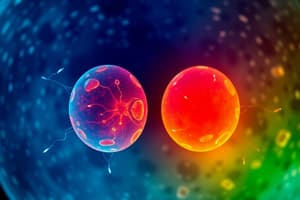Podcast
Questions and Answers
A cell with 46 chromosomes undergoes mitosis. Which of the following describes the resulting daughter cells?
A cell with 46 chromosomes undergoes mitosis. Which of the following describes the resulting daughter cells?
- Two cells, each with 46 chromosomes. (correct)
- Two cells, each with 23 chromosomes.
- Four cells, each with 46 chromosomes.
- Four cells, each with 23 chromosomes.
What is the primary purpose of meiosis in sexually reproducing organisms?
What is the primary purpose of meiosis in sexually reproducing organisms?
- To halve the number of chromosomes in gametes. (correct)
- To replicate somatic cells.
- To maintain the diploid number of chromosomes in daughter cells.
- To create identical somatic cells for growth and repair.
Which of the following processes contributes to genetic variation in meiosis, but not in mitosis?
Which of the following processes contributes to genetic variation in meiosis, but not in mitosis?
- DNA replication during interphase.
- Random assortment of homologous chromosomes. (correct)
- Separation of sister chromatids during cell division.
- Duplication of chromosomes.
A germ cell with a diploid number of chromosomes can undergo which of the following processes?
A germ cell with a diploid number of chromosomes can undergo which of the following processes?
In which of the following human cells would mitosis NOT typically occur?
In which of the following human cells would mitosis NOT typically occur?
If a cell with 2n = 20 chromosomes undergoes meiosis, how many chromosomes will each daughter cell have after meiosis II?
If a cell with 2n = 20 chromosomes undergoes meiosis, how many chromosomes will each daughter cell have after meiosis II?
Which of the following is a key difference between mitosis and meiosis II?
Which of the following is a key difference between mitosis and meiosis II?
Which of the following best describes the relationship between germ cells and gametes?
Which of the following best describes the relationship between germ cells and gametes?
A scientist is studying cell division in an unknown organism. They observe that the resulting cells have the same number of chromosomes as the parent cell. Which process is most likely occurring?
A scientist is studying cell division in an unknown organism. They observe that the resulting cells have the same number of chromosomes as the parent cell. Which process is most likely occurring?
Which of the following statements accurately compares the outcomes of mitosis and meiosis in terms of genetic variation?
Which of the following statements accurately compares the outcomes of mitosis and meiosis in terms of genetic variation?
Flashcards
Mitosis
Mitosis
Cell division resulting in two identical diploid (2n) daughter cells. Used for growth and repair.
Meiosis
Meiosis
Cell division resulting in four genetically different haploid (n) daughter cells. Used for sexual reproduction.
Somatic Cells
Somatic Cells
Cells with a diploid number of chromosomes (2n) that make up the bulk of the body.
Germ Cells
Germ Cells
Signup and view all the flashcards
Gametes
Gametes
Signup and view all the flashcards
Diploid
Diploid
Signup and view all the flashcards
Haploid
Haploid
Signup and view all the flashcards
Study Notes
Mitosis Overview
- Mitosis starts with a cell that has a diploid number of chromosomes (2n).
- In humans, this means 46 chromosomes, or 23 homologous pairs.
- After mitosis and cytokinesis, two cells are produced, each with the same genetic information as the original.
- The resulting cells also have a diploid number of chromosomes (2n).
- Mitosis is a cycle; cells can re-enter interphase, replicate DNA, and undergo mitosis again.
- Mitosis is the process by which most cells in the body grow and replicate.
Meiosis Overview
- Meiosis also starts with a cell that has a diploid number of chromosomes (2n).
- The cell replicates its DNA in interphase.
- Meiosis happens in two phases: Meiosis One and Meiosis Two.
- After Meiosis One, two cells are produced, each with a haploid number of chromosomes (n).
- In humans, this means each cell now has 23 chromosomes.
- Each of these cells will then go through Meiosis Two
- After Meiosis Two, four cells are produced each with a haploid number of chromosomes (n).
- The four cells don't necessarily have the same genetic information anymore
- Meiosis One splits the homologous pairs, so each of the resulting cells gets a random assortment of chromosomes from the individual's mother and father
- Meiosis Two is very similar to Mitosis, except it deals with cells that start with a haploid number of chromosomes
- Unlike mitosis, meiosis is not a cycle.
- The resulting cells are gametes or sex cells
- Gametes are used in fertilization.
- In males, meiosis happens in the testes, producing sperm cells.
- In females, meiosis happens in the ovaries, producing egg cells.
- Gametes fuse together in sexual reproduction to create a fertilized egg, which can then undergo mitosis to create a new organism.
Somatic vs. Germ Cells
- Mitosis occurs in somatic cells, which make up the bulk of the body
- Meiosis occurs in germ cells in the ovaries (females) and testes (males)
- Germ cells can undergo mitosis to produce other germ cells with a diploid number of chromosomes or undergo meiosis to produce gametes.
Studying That Suits You
Use AI to generate personalized quizzes and flashcards to suit your learning preferences.




